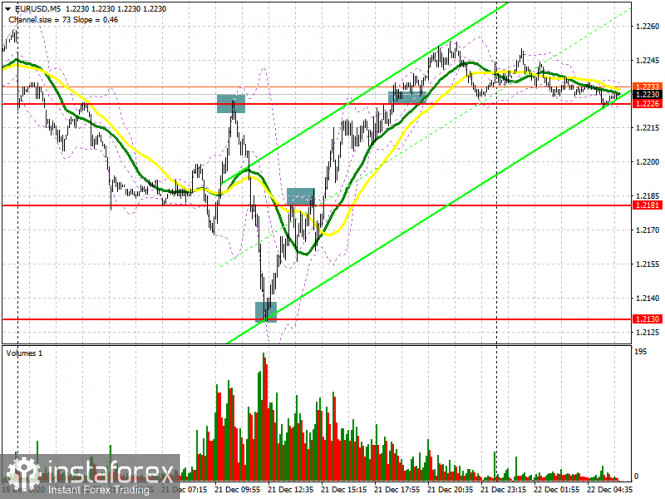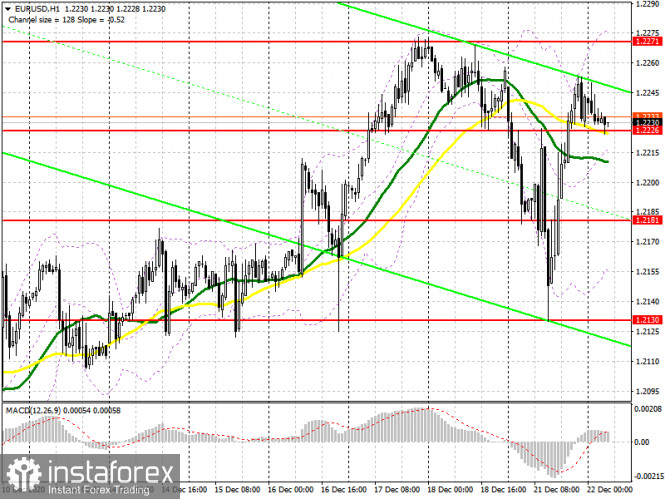
To open long positions on EUR/USD, you need:
Yesterday, the United States House of Representatives approved a new US $900 billion bailout package for the US economy, which pushed the euro against the dollar. This made it possible to win back the entire fall that was observed in the first half of the day. Good data on consumer sentiment in the eurozone also managed to support the euro during the US session. Let's take a look at the 5-minute chart and talk about where you could have entered the market in the afternoon. Buying from the 1.2130 level quickly brought the pair back to the resistance of 1.2181, where we had a false breakout and a sell signal in order to pull down the euro. However, a major downward movement did not take place, as a result of which the bulls regained control of the 1.2181 level and continued to rise from it. At the end of the day, the pair settled above 1.2226, which resulted in a signal to buy the euro, but the growth was no more than 25 points.

Today, buyers of the euro will be puzzled with protecting the support level of 1.2226 in the first half of the day, where the pair is currently trading. Moving averages also pass there, which play on the side of buyers. Forming a false breakout in the 1.2226 area will help stop the bearish momentum, which will lead to producing a convenient entry point into long positions to sustain the upward trend in order to return to a high of 1.2271. A breakout and being able to settle above this range, along with good news on the Brexit trade deal, will open new highs for euro buyers in the 1.2304 and 1.2339 areas, where I recommend taking profits. Significant reports on the state of the European economy will not be released in the morning, so the emphasis will shift to US indicators. If bulls are not active in the 1.2226 area, a breakdown of this level may take place. In this case, it is better not to rush to buy, but to wait until a larger low at 1.2181 has been updated, from where you can open long positions if a false breakout is formed. I recommend buying the pair immediately on a rebound after updating this week's low in the 1.2130 area, counting on an upward correction of 25-30 points within the day.
To open short positions on EUR/USD, you need:
Sellers of the euro aim to regain control over the 1.2226 level. Getting the pair to settle below this range and testing it from the other side will increase the pressure on the pair, which produces a good entry point for short positions. In this case, the main target will be the 1.2181 area, where I recommend taking profits. We can expect the euro to return to the support area of 1.2130, in the event that the epidemiological situation in the eurozone countries deteriorates and a new strain of coronavirus appears in Germany, France and a number of other states. If the bulls manage to defend support at 1.2226, we can expect the bull market to resurface again and EUR/USD can return to an annual high in the 1.2271 area. I recommend opening short positions from there only after forming a false breakout. It is best to count on selling on a rebound only after testing 1.2304 and 1.2339, counting on a downward correction of 20-25 points within the day.

The Commitment of Traders (COT) report for December 15 showed an increase in short positions and a reduction in long ones. Although buyers of risky assets believe that the bull market will proceed, especially amid expectations of vaccinations in the eurozone, which will begin from December 25 to 27, however, the rush to buy at current highs has obviously decreased. Thus, long non-commercial positions fell from 222,521 to 218,710, while short non-commercial positions increased from 66,092 to 76,877. The total non-commercial net position fell from 156,429 to 141,833 a week earlier. The growth of the delta, which was observed for three consecutive weeks, has stopped, so one can hardly count on the euro's rapid growth at the end of this year. There will be no further major recovery until European leaders negotiate a new trade agreement with Britain.
Indicator signals:
Moving averages
Trading is carried out slightly above 30 and 50 moving averages, which indicates the buyers' attempt to continue the upward trend.
Note: The period and prices of moving averages are considered by the author on the H1 hourly chart and differs from the general definition of the classic daily moving averages on the daily D1 chart.
Bollinger Bands
A breakout of the upper border of the indicator in the 1.2271 area will result in pushing the euro to the upside. A breakout of the average border of the indicator in the 1.2220 area will increase pressure on the pair and the euro to fall.
Description of indicators
Moving average (moving average, determines the current trend by smoothing out volatility and noise). Period 50. It is marked in yellow on the chart.Moving average (moving average, determines the current trend by smoothing out volatility and noise). Period 30. It is marked in green on the chart.MACD indicator (Moving Average Convergence/Divergence — convergence/divergence of moving averages) Quick EMA period 12. Slow EMA period to 26. SMA period 9Bollinger Bands (Bollinger Bands). Period 20Non-commercial speculative traders, such as individual traders, hedge funds, and large institutions that use the futures market for speculative purposes and meet certain requirements.Long non-commercial positions represent the total long open position of non-commercial traders.Short non-commercial positions represent the total short open position of non-commercial traders.Total non-commercial net position is the difference between short and long positions of non-commercial traders.